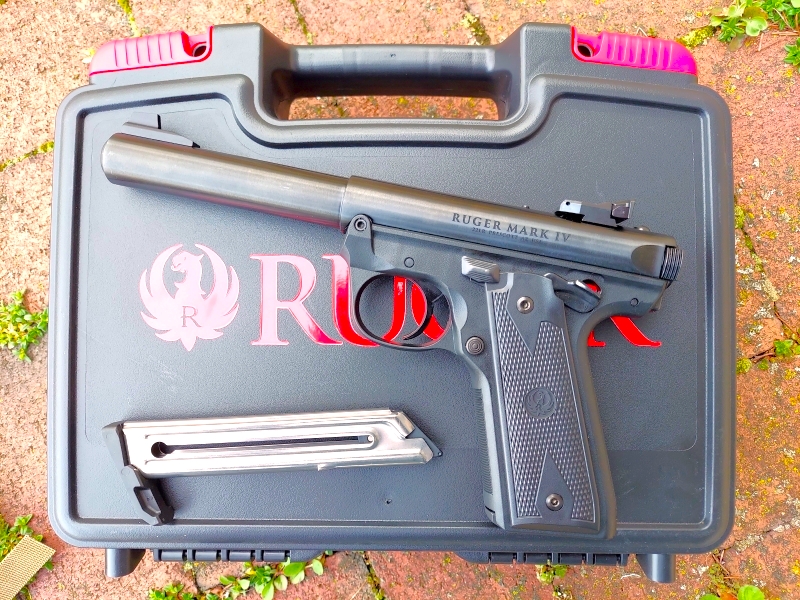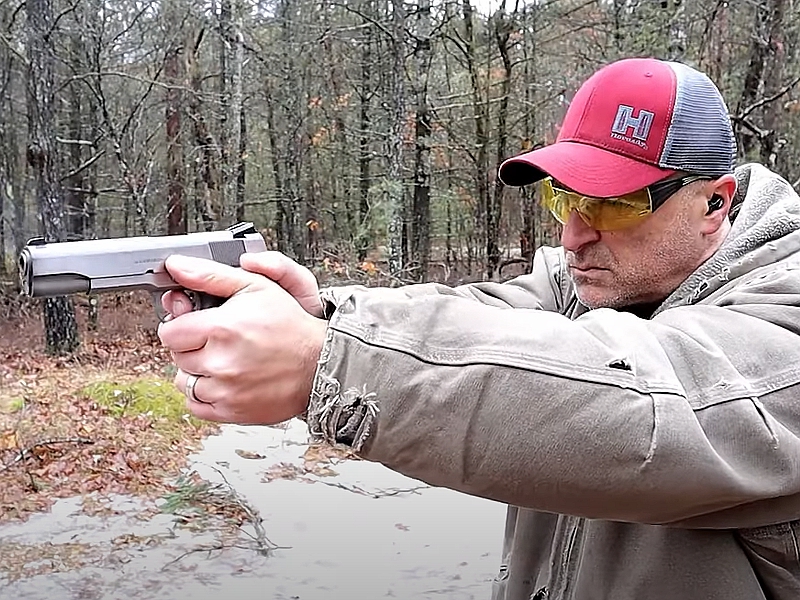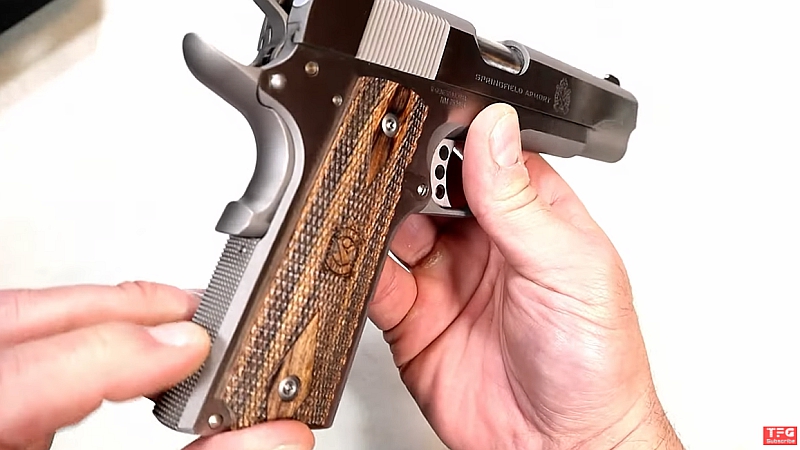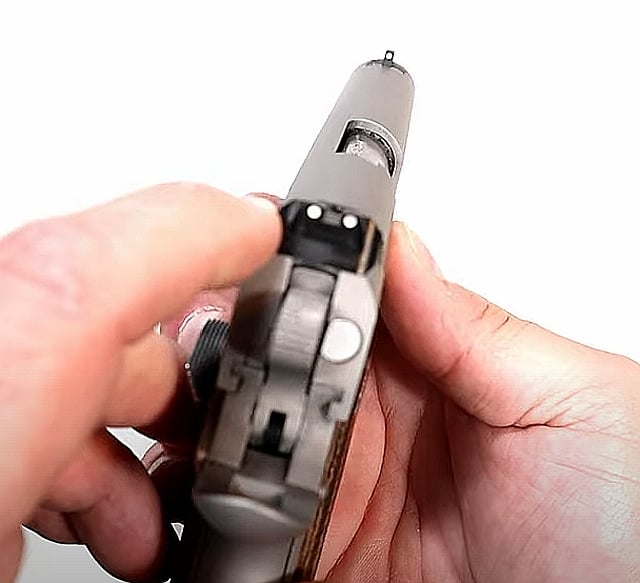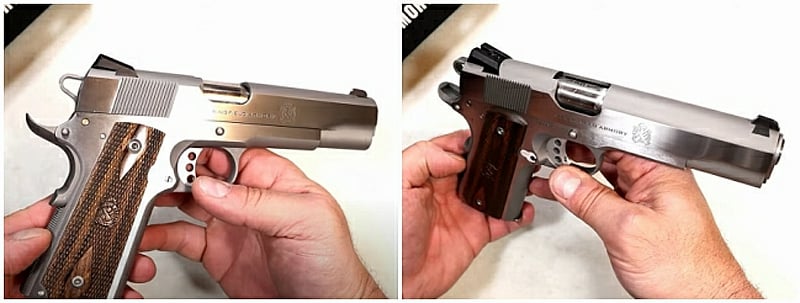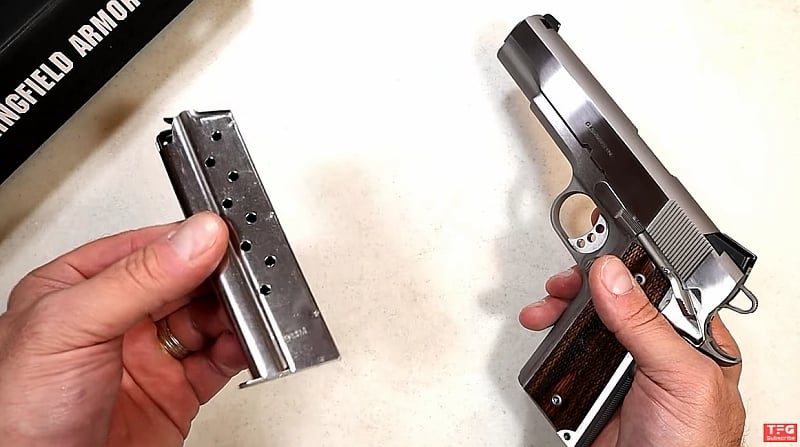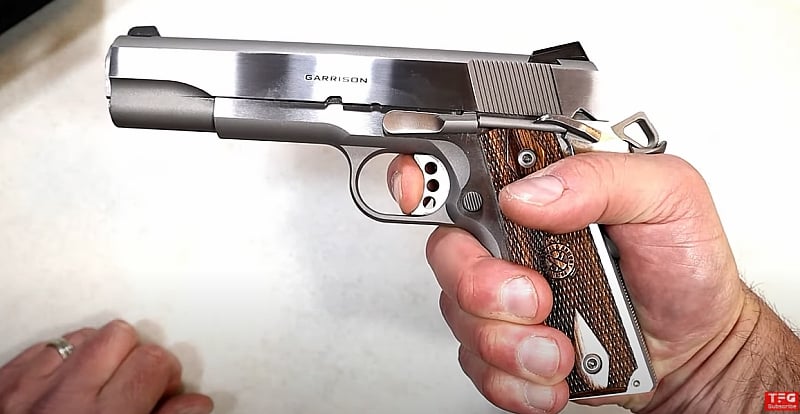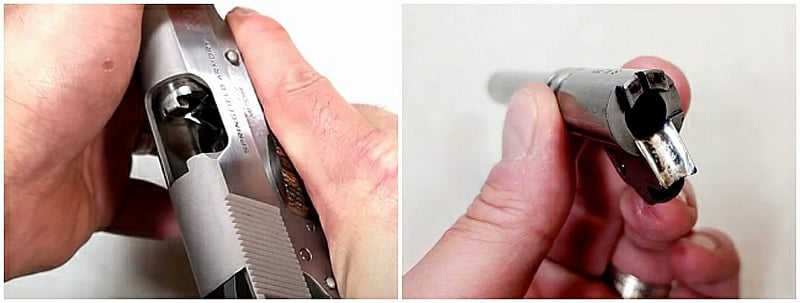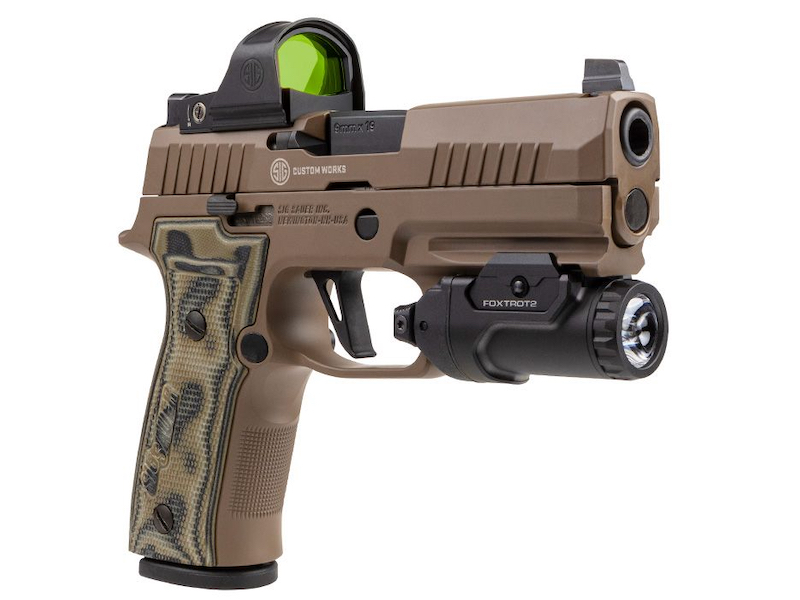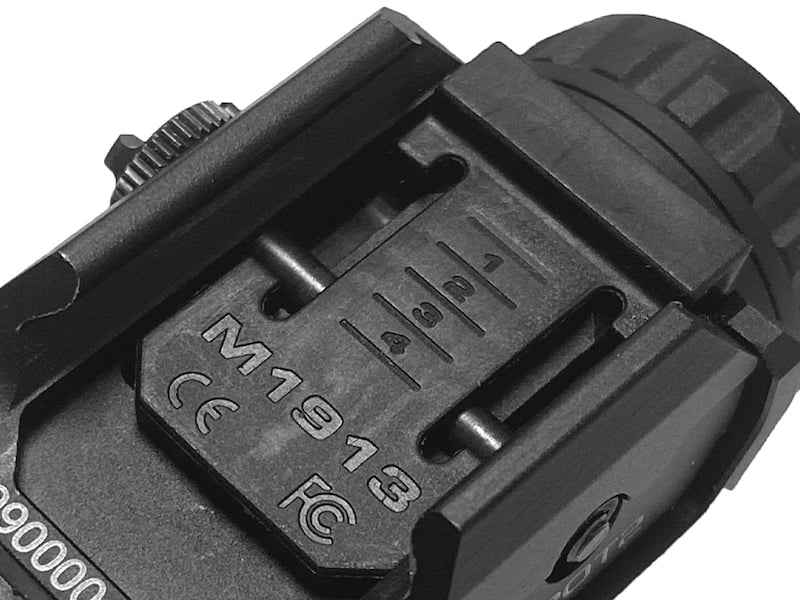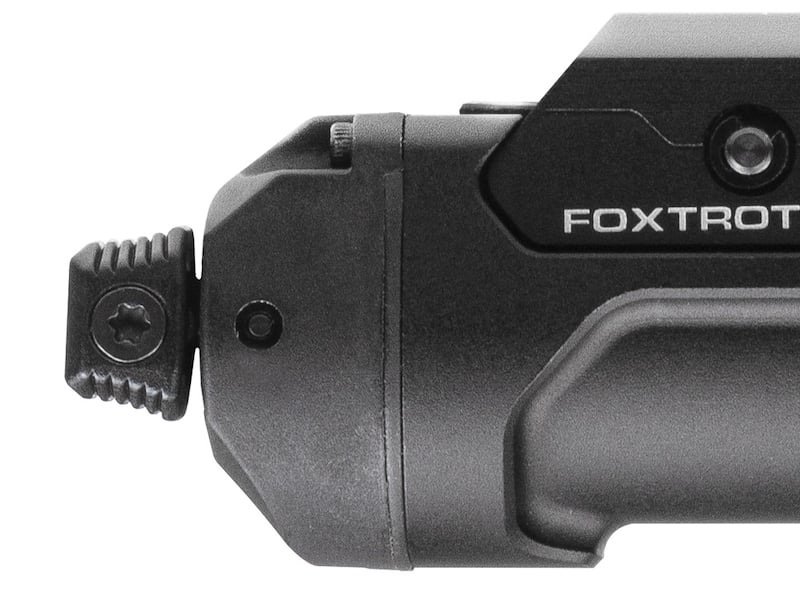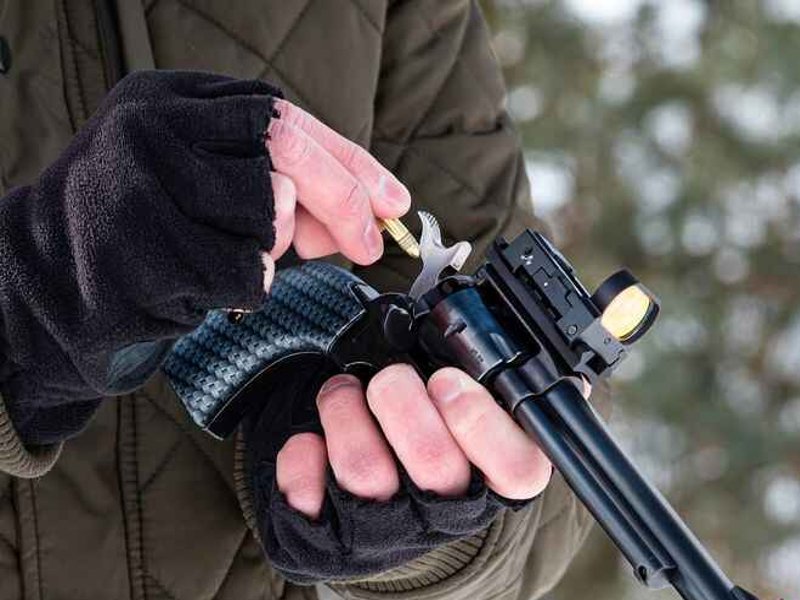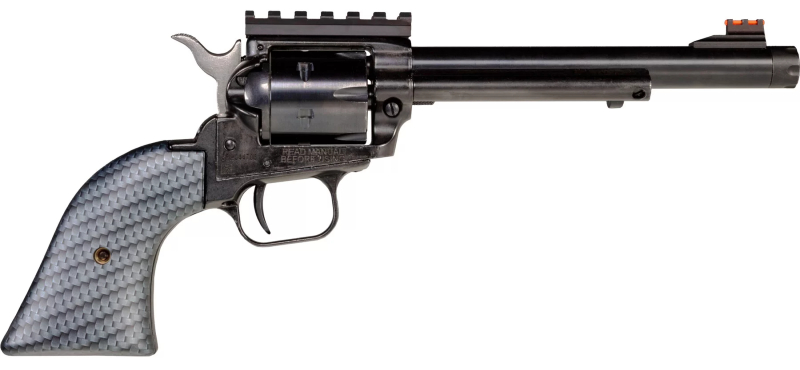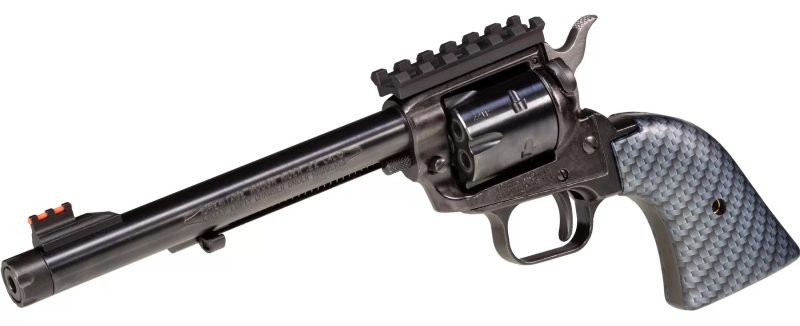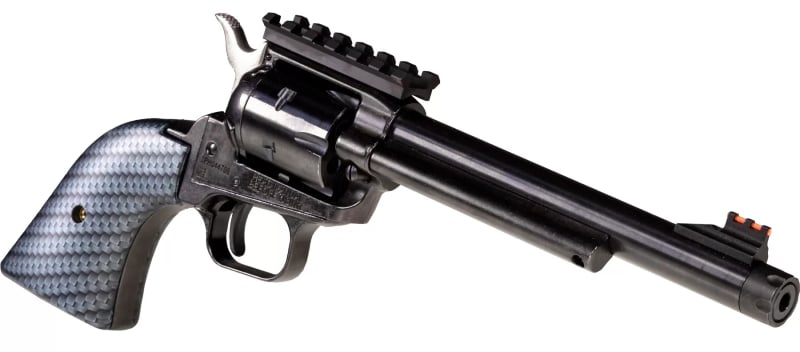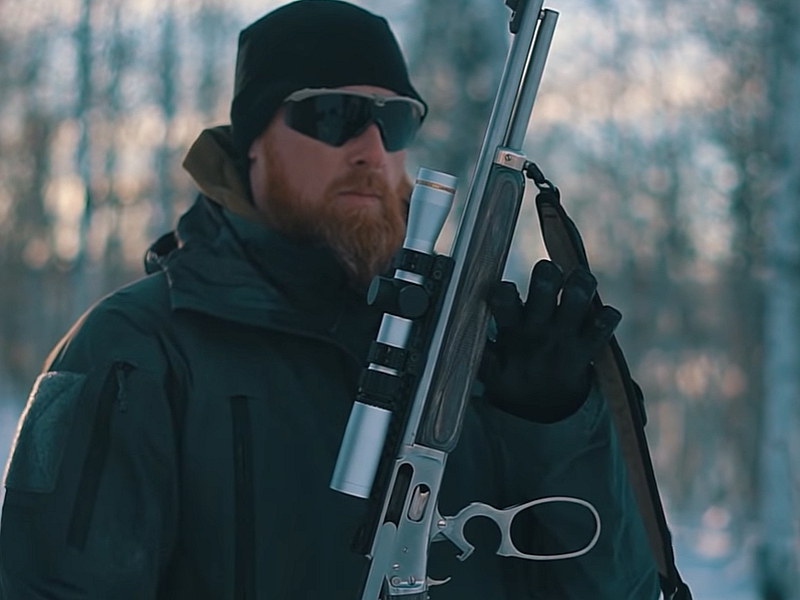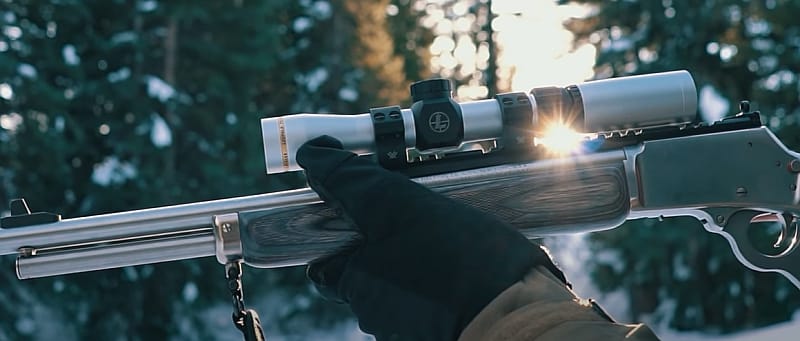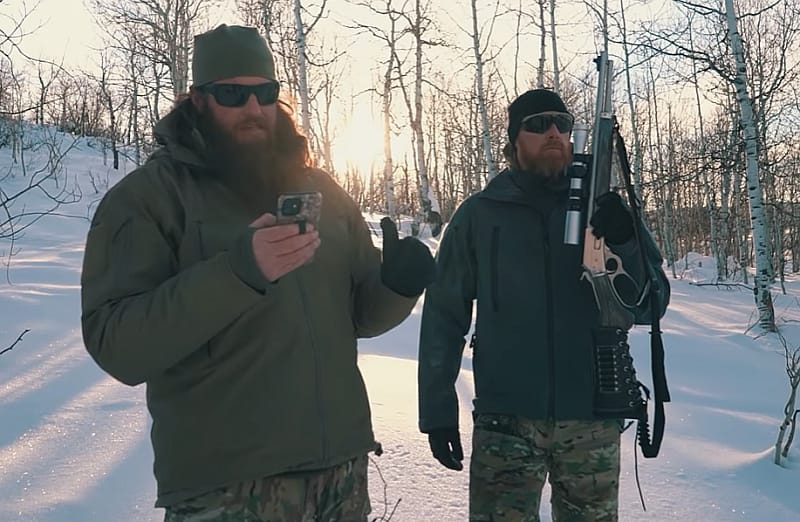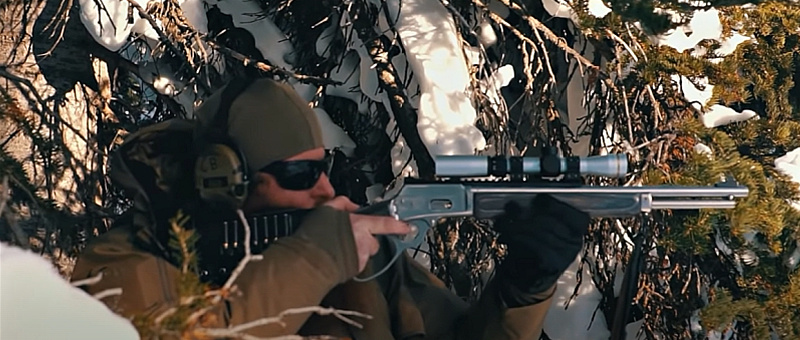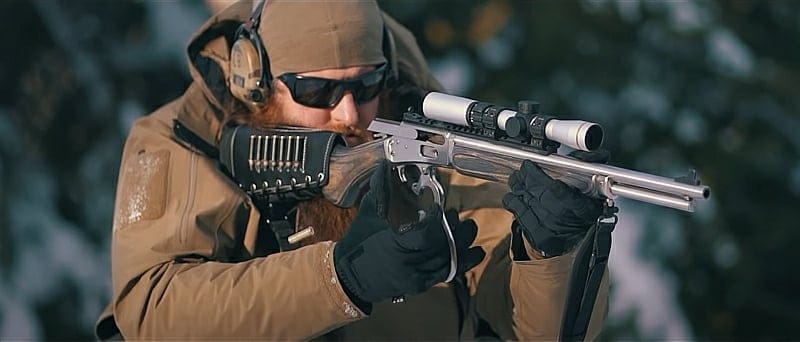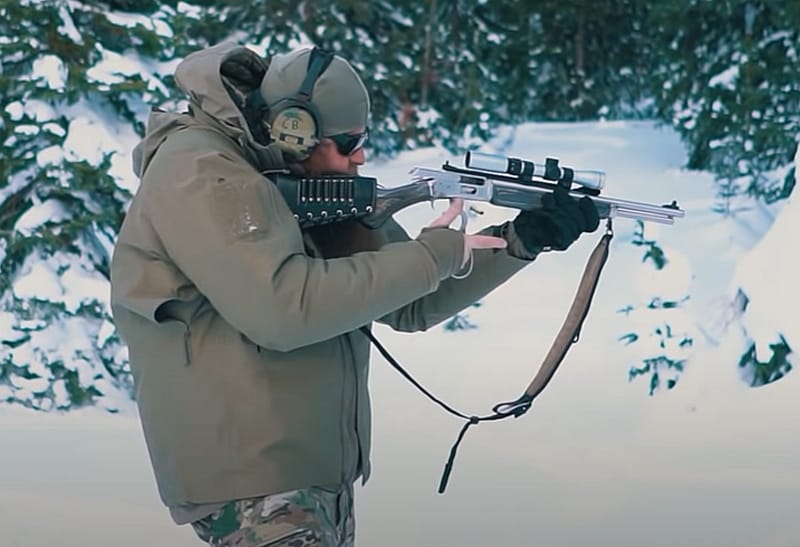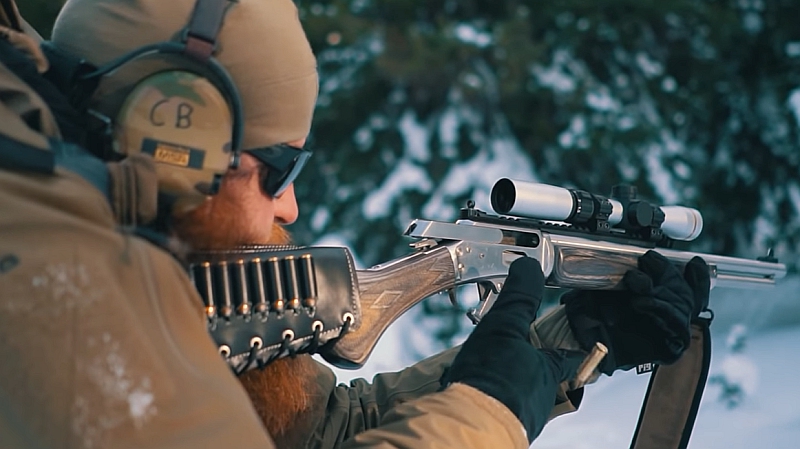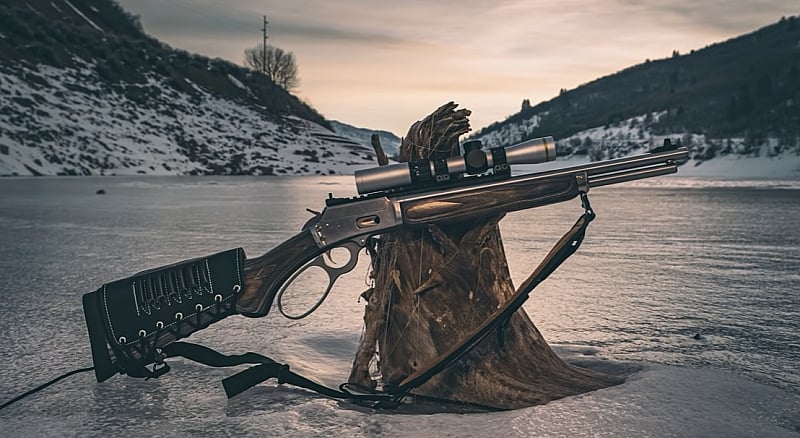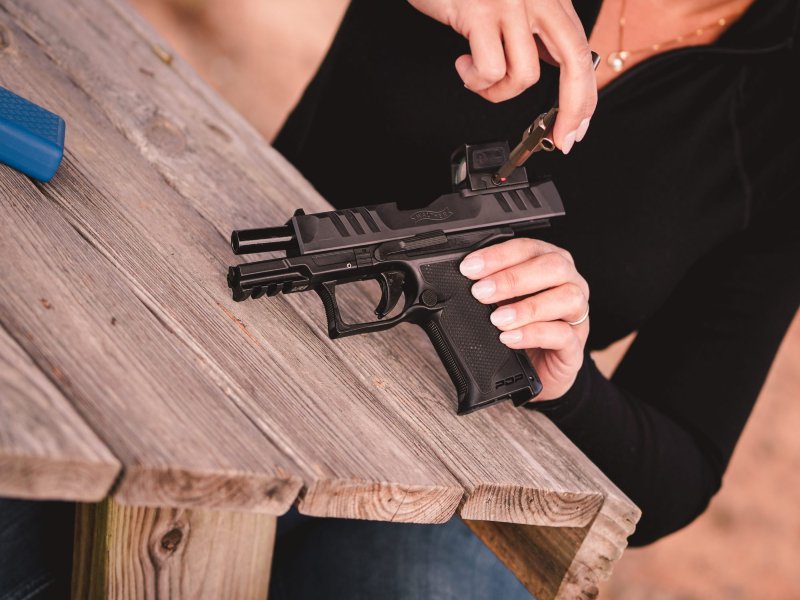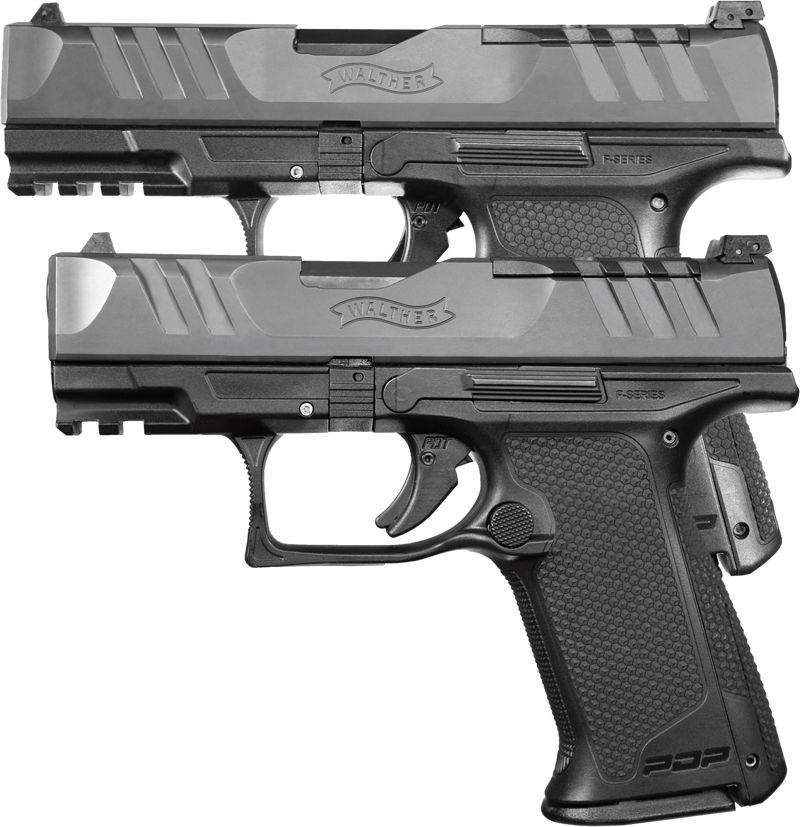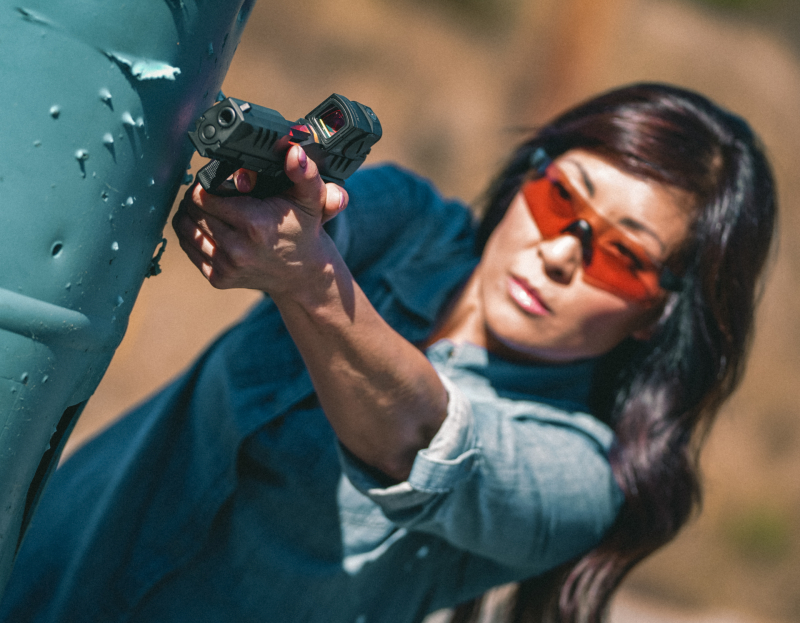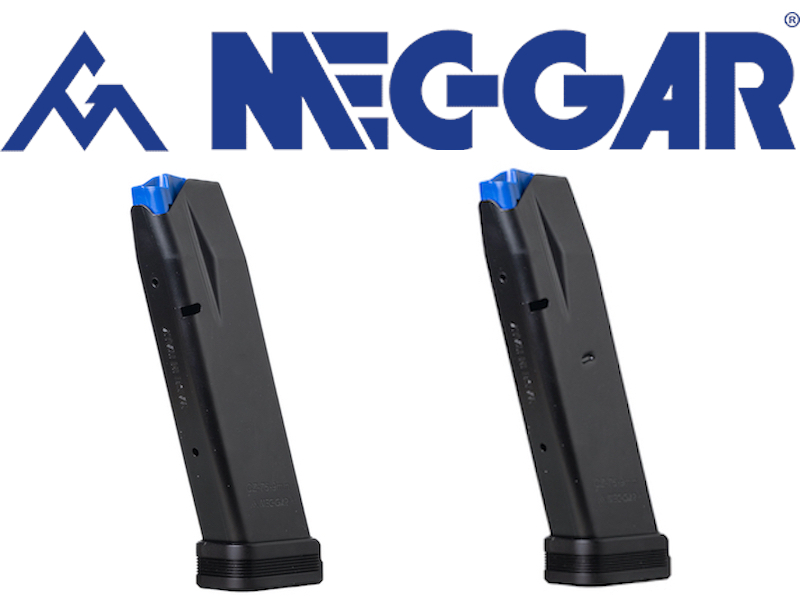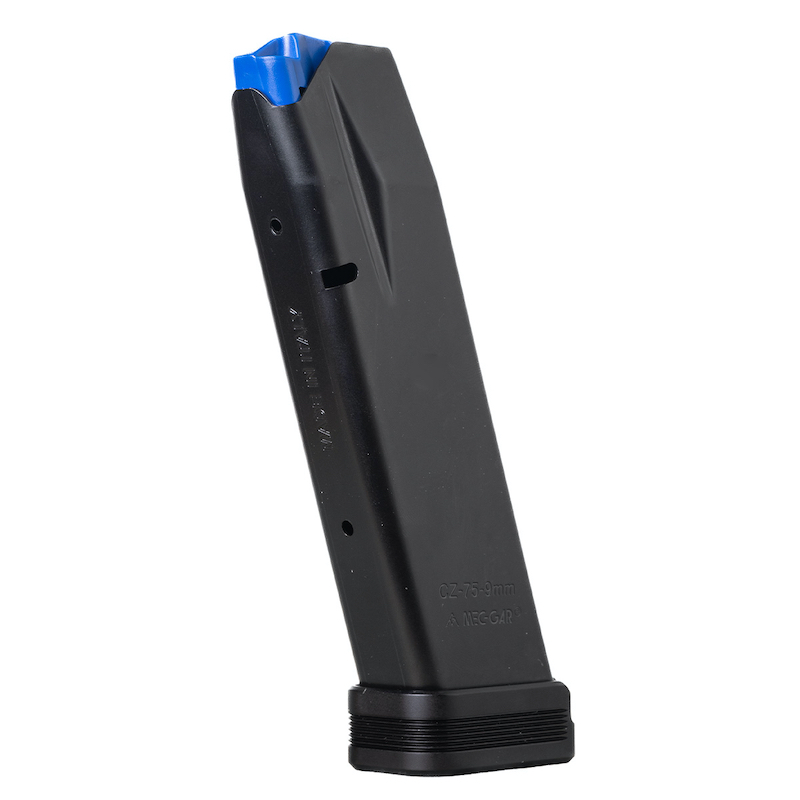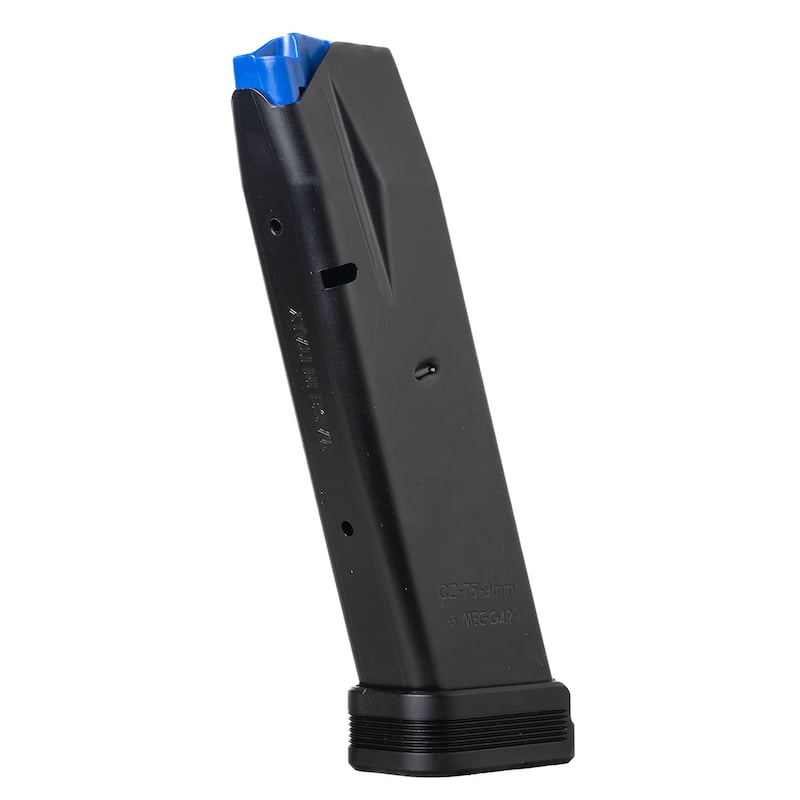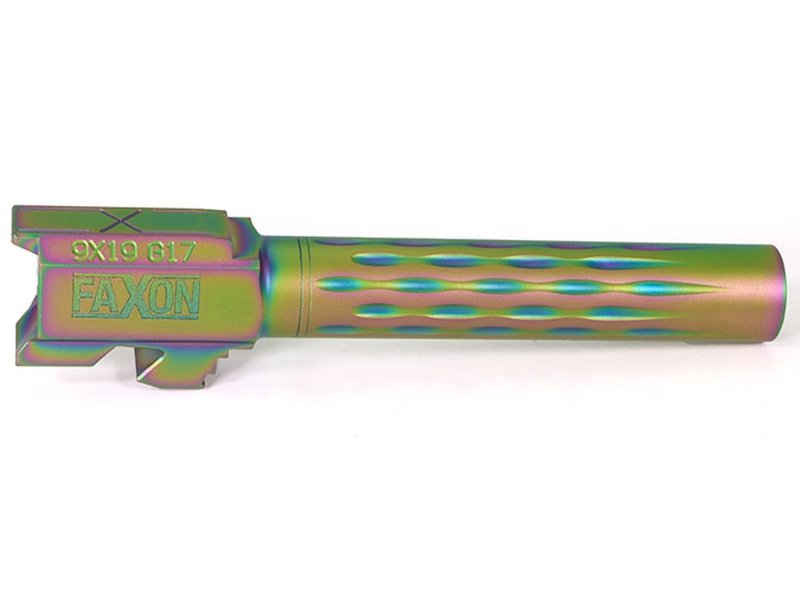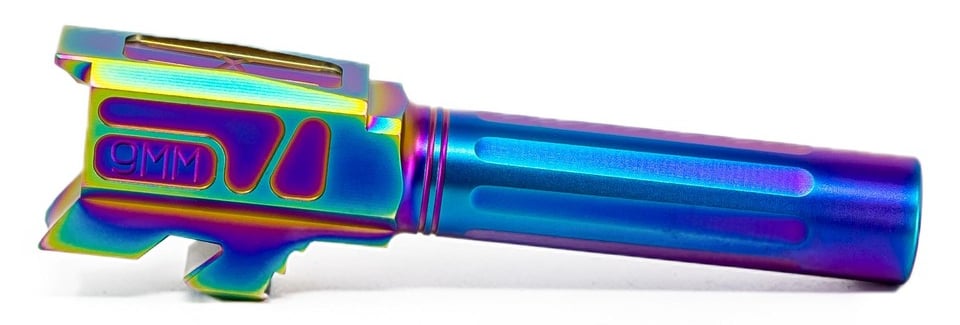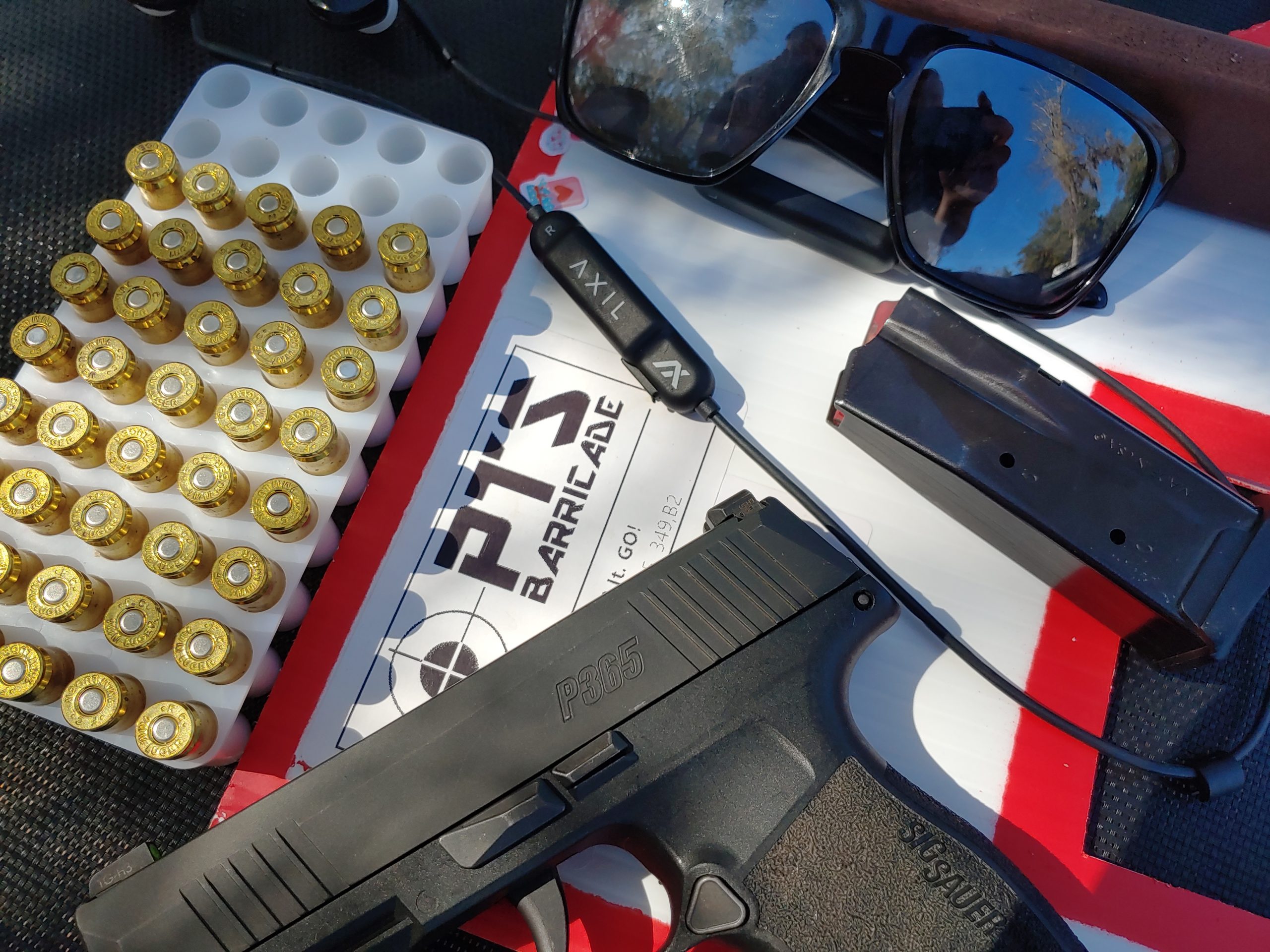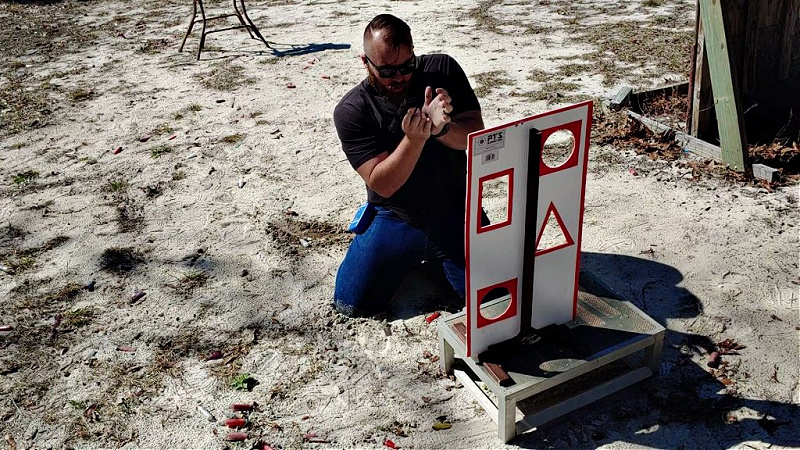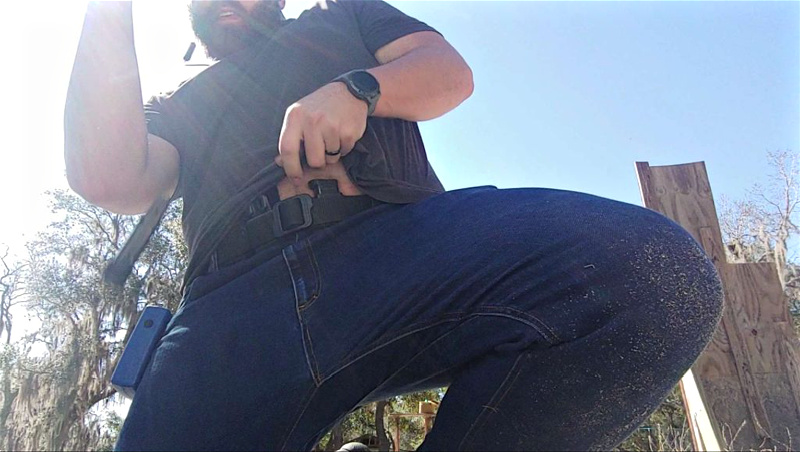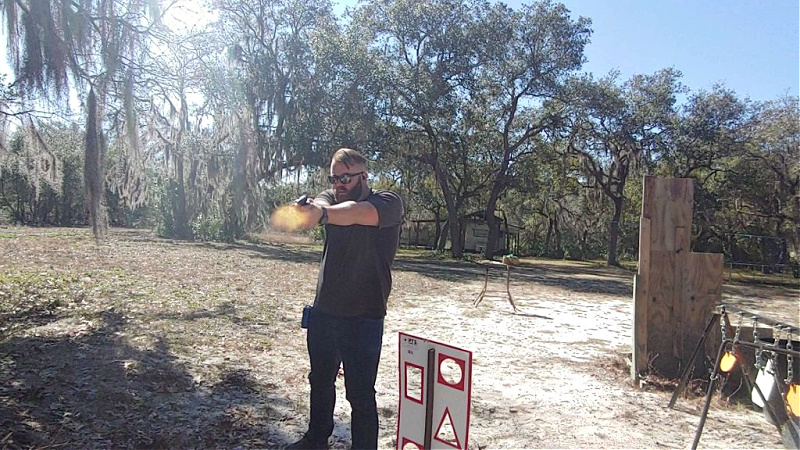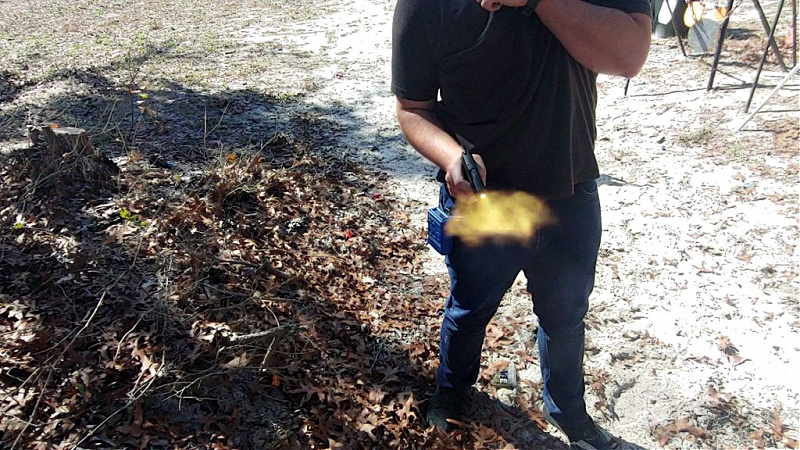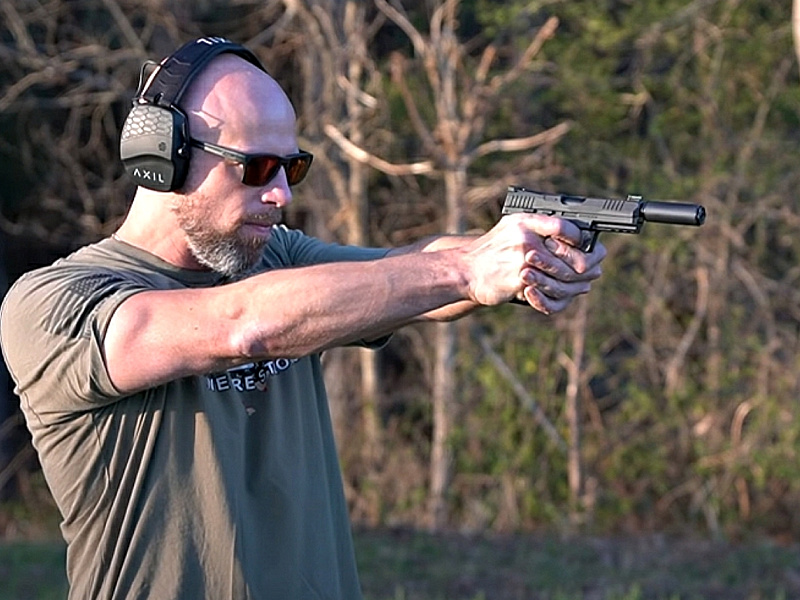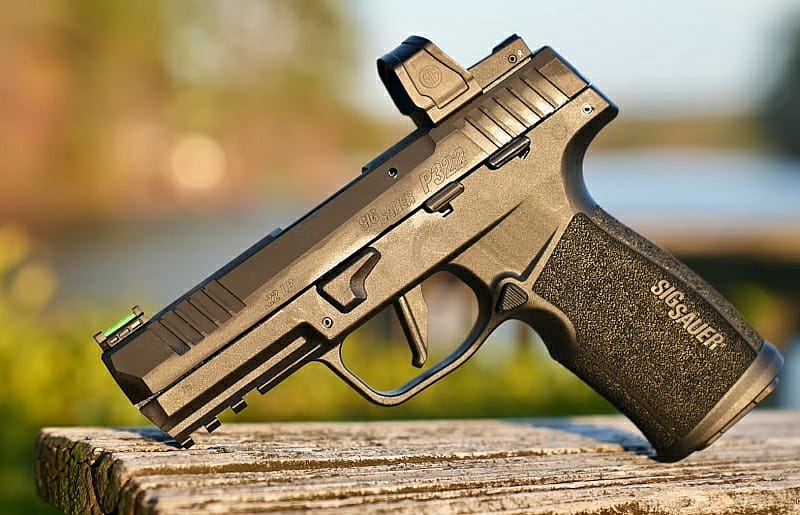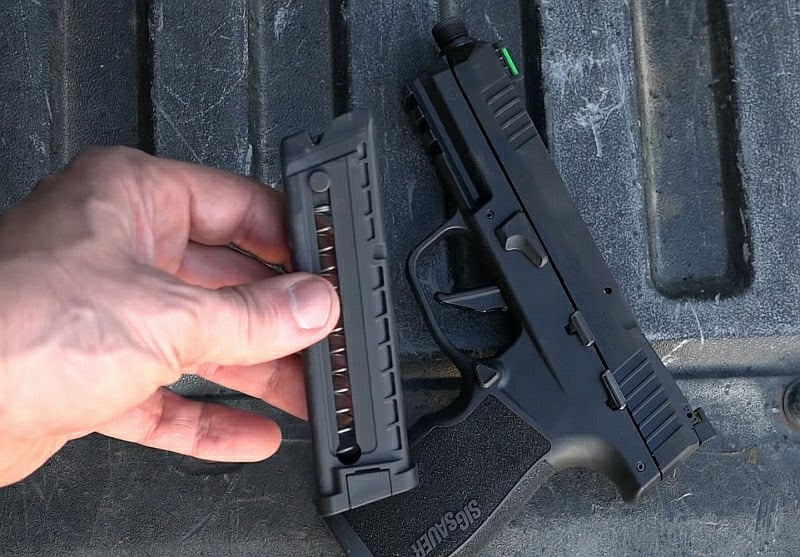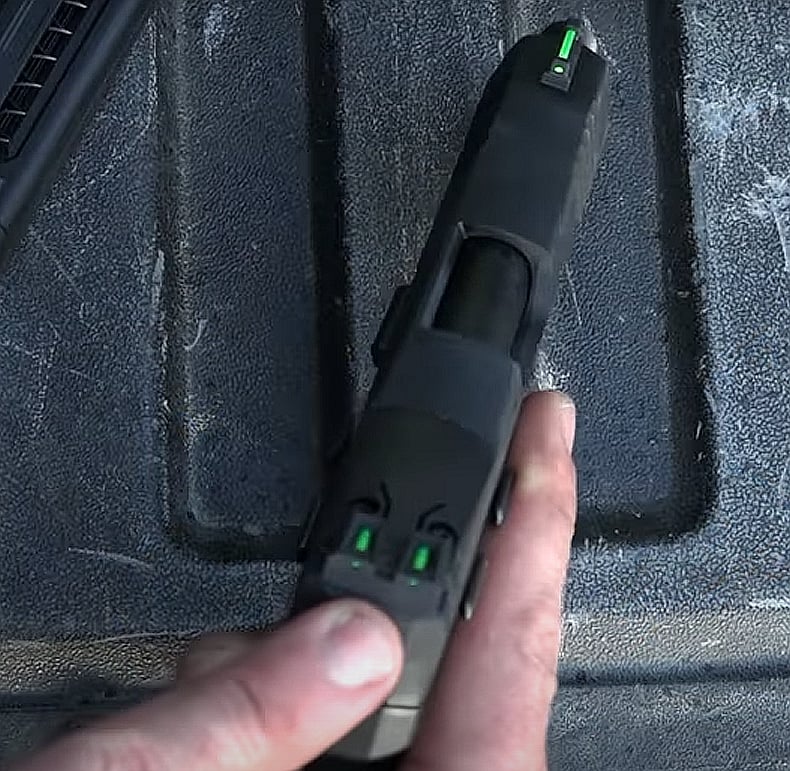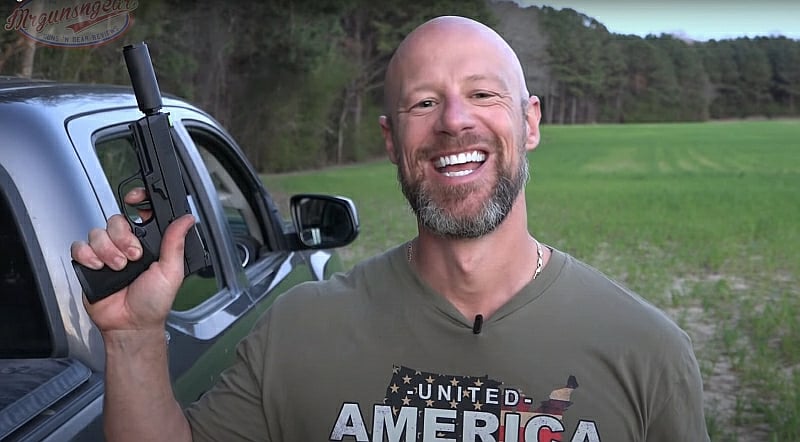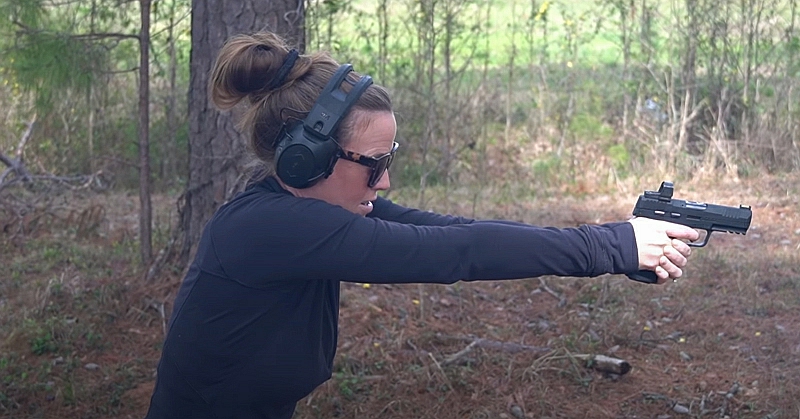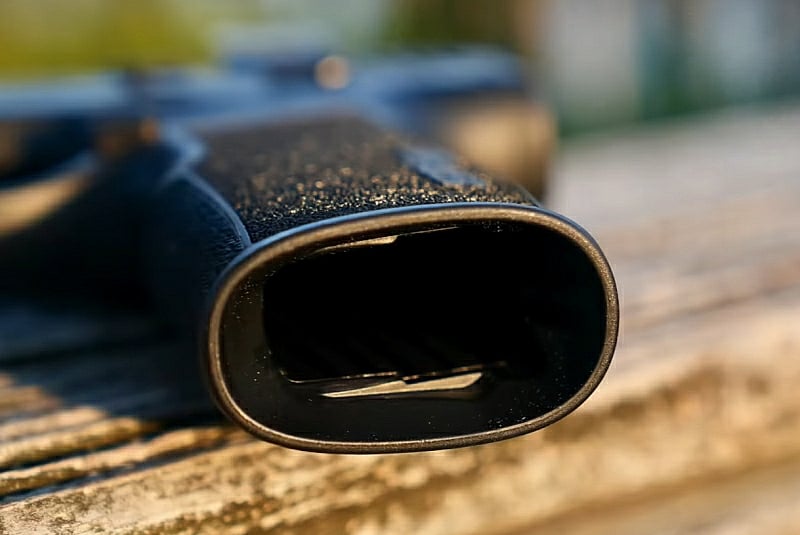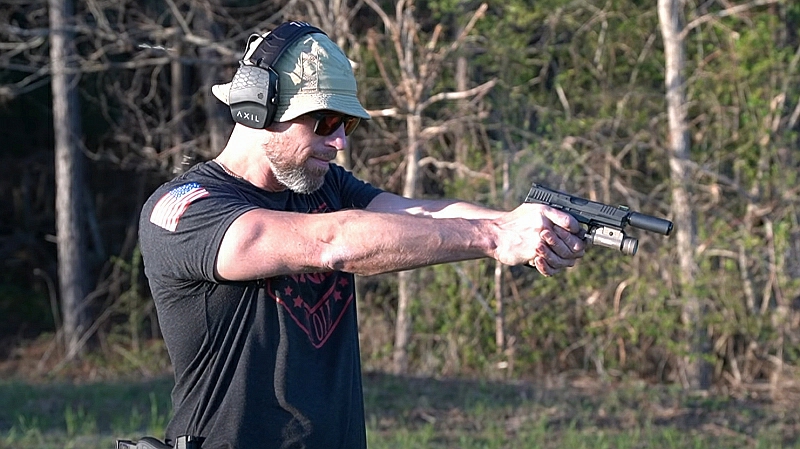Ruger Mark IV 22/45 – The Mag Life
Back in 1949, the Mark I .22 Long Rifle caliber pistol was introduced by Ruger, and it just so happens that this was their very first product! At the time, its general profile was somewhat similar to the German Luger of World Wars I & II fame. Fast forward to present day, Ruger is now on the Mark IV series.
The Mark I, II, and III series are all excellent pistols but they had one irking factor that shooters weren’t very fond of. More on that later, and why it led to the Mark IV series.
I confess that I’m a .22 Long Rifle whore. There, I said it. They tell me that the first step is admitting that it’s a problem. Except, it’s not a problem because I can stop any time I want, honestly! So a Ruger Mark IV 22/45 pistol followed me home.
Basic Features of the Ruger Mark IV 22/45
The pistol is chambered in .22 Long Rifle and features a 5.5-inch long bull barrel (complete with recessed target crown), which helps the pistol balance extremely well. It’s not a lightweight pistol, but the outstanding balance really evens things out. Immediately upon picking it up, It felt almost “heavy” in my hand. I say almost because it’s not a particularly heavy pistol, it’s just well put together. It’s 34.4 ounces, so it’s not a featherweight, but considering the heavy barrel, I don’t see the weight as being excessive. Perhaps “solid” is a better descriptive term.
The frame is Polymer and the grips (which are removable and can be replaced) are “synthetic.” Grips that are wood and comprised of other materials can also be had if the user desires. The grips resemble those of a 1911 and feel really comfortable in the hand. I actually had to do a double take when I read that the frame is made from Polymer; I’d thought it was metal because it is so solid, and it actually feels like metal. The receiver is made from alloy steel. The front of the grip is serrated and the backstrap is checkered, which adds to the positive grip. Overall, the entire grip strongly resembles a 1911 in angle, girth, and feel.
On top of the receiver, there are holes drilled and tapped so that a Picatinny or Weaver rail can be easily added for mounting optics and such. Some other versions of the Mark IV actually come standard with the rail attached, and the option to add one easily is a welcomed option.
The overall length of the Ruger Mark IV 22/45 is 9.75 inches and the height is 5.5 inches. As far as pistols go, this one is on the larger side. But then, it’s not something you’re likely to try to slip into a pocket for concealed carry. There is a 22/45 Lite version that is smaller and…you guessed it…lighter, and such a pistol might be better suited in the event that someone would want to carry it concealed. That said, these pistols really aren’t intended for the concealed carry crowd.
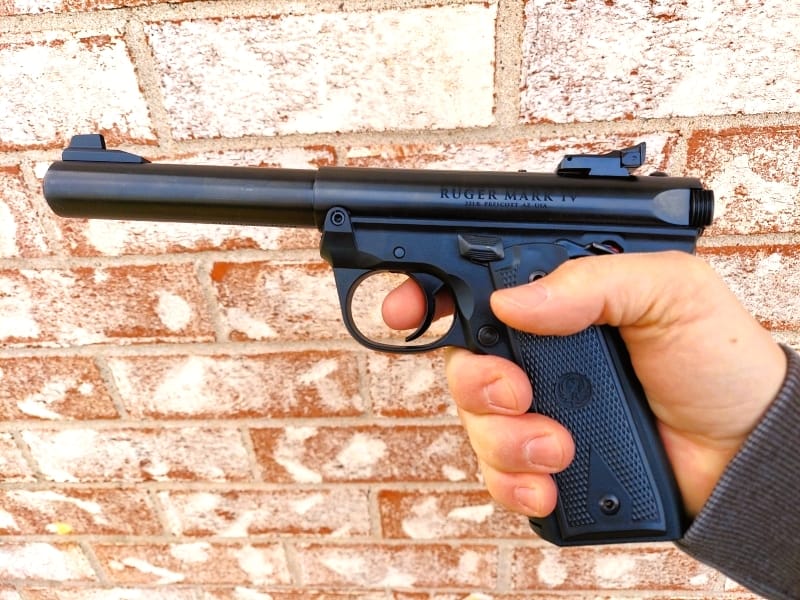
Attracted to their accuracy and durability, I had wanted one of the Ruger Mark series pistols for a number of years, but I heard horror stories about field stripping and cleaning them. Those accounts always turned me off, as I’m not the most mechanically inclined person on the face of the earth. In fact, I’m a complete simpleton when it comes to such things. Ruger listened to peoples’ complaints, and in 2016, they introduced the Mark IV series.
What really turned me on to the Ruger Mark IV 22/45 was when I saw how easy it is to take down. Push one button, and the receiver pops up similarly to that of an AR-15, and the entire upper receiver detaches from the lower. The bolt pops right out! That’s it! So easy I can do it in about two seconds (literally). Remember that irking factor that I’d mentioned at the beginning of this article that shooters didn’t care for? Ruger is on top of their game and remedied that issue forever.

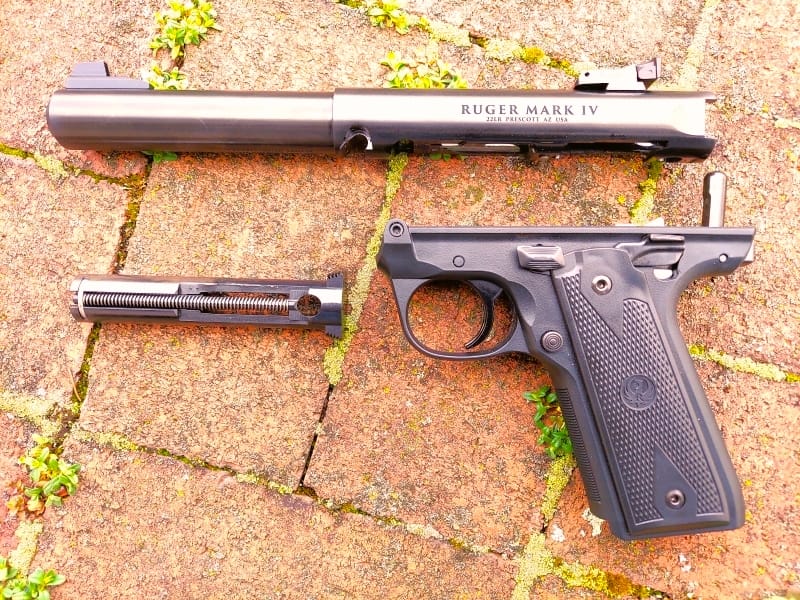
The construction of the bolt is cylindrical, as is the receiver, so the two fit together well.
The magazine release is conventionally located on the frame so that it can be activated with the thumb. It’s easily pressed and the magazine ejects positively (dare I say forcefully). Speaking of magazines, the Mark IV mags hold ten rounds and are constructed ruggedly. They’re very easy to load, as they have buttons on the mag that you can pull down, relaxing the spring, so the rounds can easily be loaded. Two magazines are shipped with each Mark IV pistol.
One thing that I don’t care for is the fact that there’s a magazine disconnect, so the pistol will not fire without a magazine inserted. I’d prefer to be able to fire it without a magazine. This isn’t a deal-breaker, but it is what it is.
Now we come to the safety, which is very well executed on this pistol. It operates very similarly to a standard 1911, and is easily swiped off without a lot of effort to fire the pistol. The placement is outstanding; it’s right there where you’d expect it to be. All in all, the safety gets the highest marks. An added bonus is that the safety is ambidextrous. Ruger had this one easy; they just emulated the 1911 style safety, and couldn’t have done a better job.
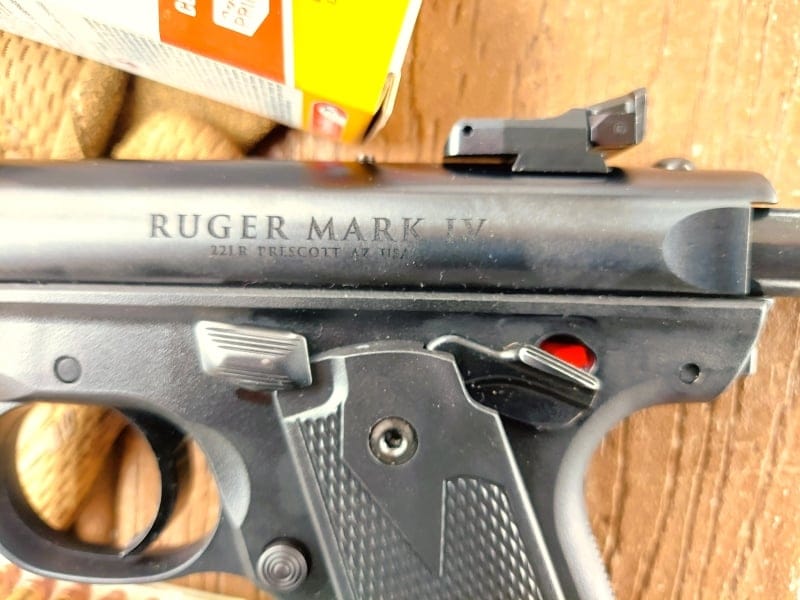
The slide release is just forward of the safety, and it is a good one. Normally, I don’t much concern myself with slide releases, instead preferring to release or withdraw the slide by grasping over the top of the slide and pulling back with my hand. However, with the MK IV, one cannot do that because the bolt is enclosed in the receiver (as we mentioned, like an AR-15). As such, there is no conventional slide, the bolt moves within the receiver; instead, one has to grasp the cocking tabs or “ears”, at the rear of the receiver to charge the pistol. To be fair, this is not difficult. However, for those who are used to simply going over the top of the slide with the palm of the hand, we will need to revamp our method for this pistol. It’s a mild inconvenience that I wouldn’t consider to be the end of the world, but just be aware of it.
When the last round is fired, the bolt is locked to the rear. At the range, though, I found that I naturally placed my thumb on the slide release, so the slide often did not hold open after the last round was fired. That’s a software problem (the shooter) and not a hardware problem (the firearm).
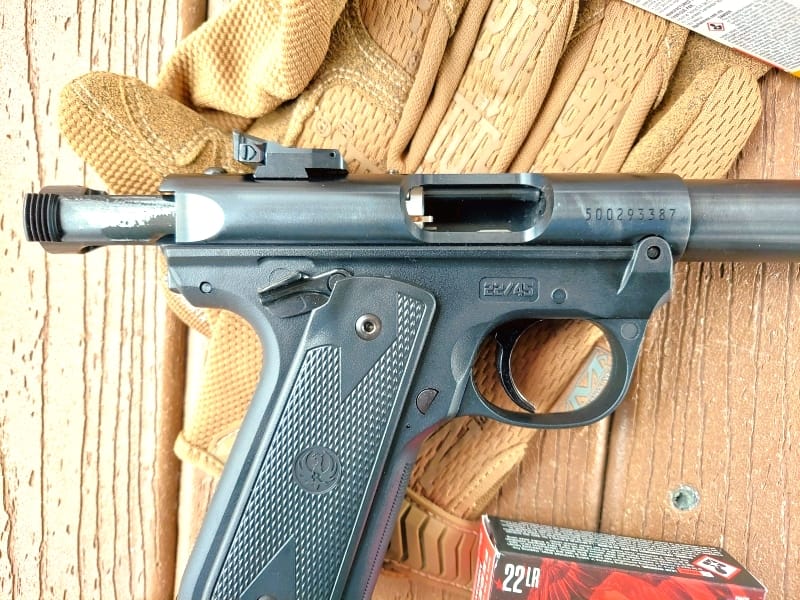
Next we come to the sights. There are things that I like, such as the rear sight being adjustable. One thing that I dislike is the fact that the front sight (a ramp type) is all black. For me, it really needs to have either a dot or some color on it. For that matter, the rear sight is also all black, though this is not as critical for me. I believe I’m going to use an old trick that a buddy taught me and put a dab of fluorescent nail polish on the top of the front sight ramp to help me to be able to see it better. Aside from that, the sights seem to be just fine with the pistol. I also understand that one can purchase a different front sight post, which is held on by a screw and should change out very easily. I will look into acquiring one of those.
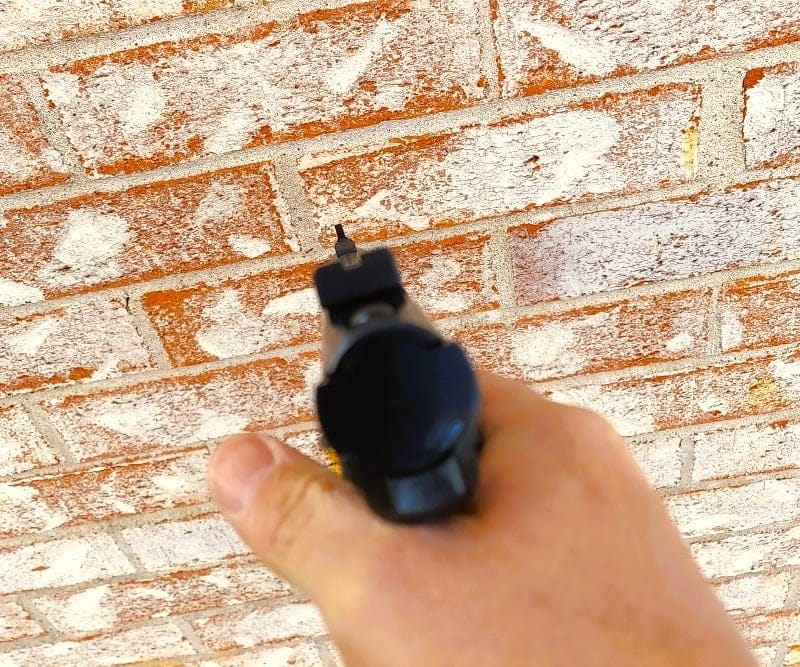
Why did I buy the Ruger Mark IV 22/45?
It’s doubtful that I’m going to carry it concealed for protection. However, I will be using it to give my family some trigger time and run them through some shooting drills to get them more accustomed to such things.
It will also be used a bit just for fun. I seldom shoot for “fun” anymore. Each time I go to the range, I follow the advice of my friend and fellow instructor (Bob): always have an agenda, a schedule to improve one or more skills for each range session. Well, I’m still going to do that, but considering this pistol is a .22, I will also enjoy shooting it. I will still run drills incessantly, but there will be some fun had along with it all.
Beyond that, it’s just a good idea to have a .22 pistol that you can throw in a day pack and take with you on an outing, along with several hundred rounds. Between the pistol and ammo, the extra weight won’t add much to the pack, and you’ll likely not even realize you’re carrying it. Unless you happen to need it.
That brings me to my next point: the .22 Long Rifle. That’s really the reason that I bought this pistol, I wanted a .22 pistol.
Why the .22 LR? Those who know me might be rolling their eyes right now because they realize I’m going to beat a dead horse again about the virtues of the .22LR. If you haven’t heard this spiel yet, you may find it interesting. If you have…read it again anyway because it’s true.
.22 Long Rifle Virtues
It’s inexpensive.
Which means you can stock up on a LOT of rounds for a rainy day (and currently, it appears that we may have a rainy day coming). What’s more, you can actually afford to practice and train a whole lot more with the .22LR than with, say, .45 ACP. At the time of this writing, my local gunshop has .22LR for about $11.95 per 100 rounds of CCI, which is generally agreed to be the Gold Standard by which .22 ammo is judged. Bulk packs cost about $50 for 500 rounds, depending on the brand and quality. Some is more, some is a little less. Quality does vary, but generally, most of it is pretty decent stuff.
It’s light and compact.
The .22LR is smaller than almost any other round on the planet. Especially when compared to other pistol bullets. It weighs less and takes up far less space. A brick of 500 will fit into a backpack easily and weighs a couple pounds.
It’s than quieter than other calibers.
This helps the shooter if he’s trying to be more discreet, although this is more-so true in rifles than pistols. Still, it’s not as noisy as many other rounds. That makes it easier on the ears, and the sound does not carry as far, so shooting the .22 is more discreet.
Far less recoil than other calibers.
This is great for new shooters because they won’t become recoil sensitive as with some other calibers. For experienced shooters, this allows a high rate of fire without recoil throwing them off target. A win/win for all involved.
There is a wide variety of .22 ammo configurations available,
Options range from subsonic rounds to match rounds. Hunting rounds, target rounds, and all sorts in between. There’s even birdshot and snakeshot. Note that not all of them will cycle semi-autos reliably, so a bit of research and some testing on your part will be time well spent.
Its popularity ensures that it will be available wherever bullets are sold.
Those are many of the advantages, but there are a few disadvantages as well. The powder used in .22 ammo often burns dirtier than other rounds, and can gum up the action of your firearm(s). And the round itself is not as powerful as most others. Yes, there are tradeoffs, but I believe, for many purposes, the advantages outweigh the costs. Is the .22LR the ultimate round for every purpose? Not by a long shot. However, as a long-term survival round, it is very hard to beat!
I typically buy a few boxes of ammo each week, and over time, that adds up. I look at this caliber as a long-term investment, and long after I’ve expended my other calibers in a disaster scenario, I’ll still have .22LR in supply. My advice is to buy it when it’s available to you, as there is no guarantee how long it (or any other item these days) will be on the shelves. We’ve seen how panic buying can wipe out store shelves.
At The Range
As expected, reliability with the Ruger Mark IV 22/45 was superb. There was one misfire, which turned out to be a generic .22 round that I rechambered and it still would not fire. It turned out to be faulty ammo, rather than the pistol’s fault. In the end, the pistol’s reliability was perfect.
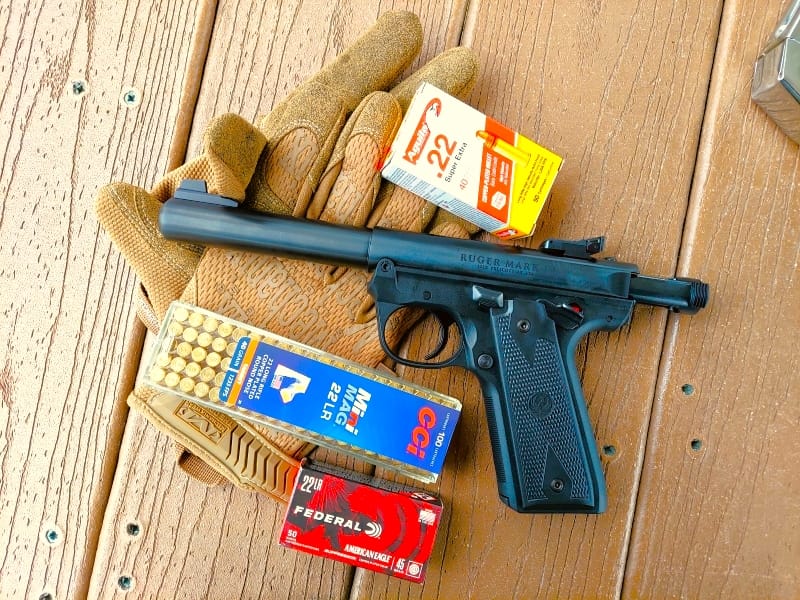
I ran several brands of ammunition through it, including CCI (the gold standard of .22 ammo), Aguila, Federal, and some other bulk pack ammo. Suffice to say that the 22/45 will likely run with anything that you can stuff into the magazines.
Regarding the magazines, as mentioned, the button on the side makes it nice to load them. When you pull down on the button, the spring tension is released so that feeding the rounds into the magazine is much easier. They are also fairly sturdy affairs and are likely to last a long time. I’m going to pick up a few more at GunMag Warehouse, as it’s always nice to have a few spares on hand.
Accuracy was, in my opinion, extremely good. The best group of the day that I shot was 2 ½ inches at 15 yards from the offhand position. Given the fact that I had a 25-mile-per-hour wind hitting me in the face when it was 40 degrees, I consider that to be pretty decent. Undoubtedly, the pistol is capable of better accuracy than I am, and under better conditions, I’ve no doubt that groups will improve. As it stands, that size of a group is pretty good for a pistol.
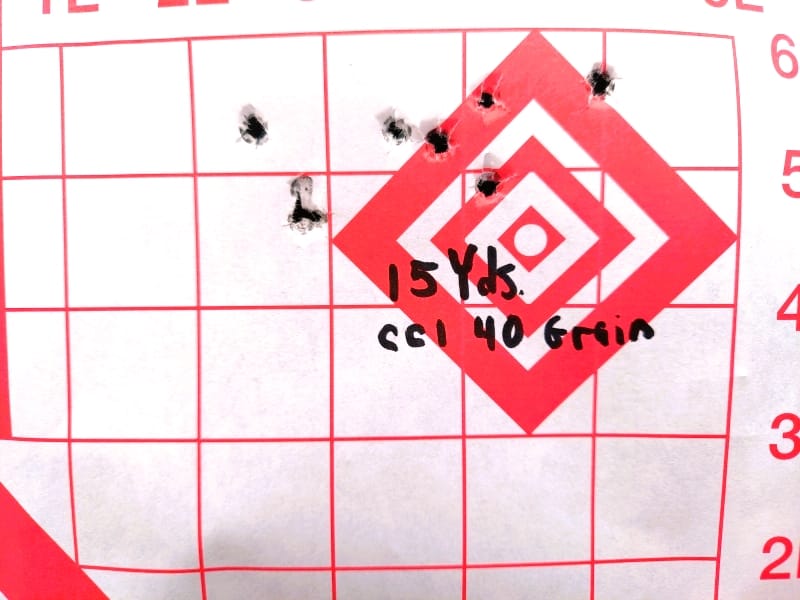
At one point, my daughter wanted to try the Mark IV out, so I let her shoot a few magazines through it. She exclaimed, “It’s pretty quiet and there’s almost no recoil!”
I replied, “Well, that’s kind of the point.” The .22LR just seems to endear itself to shooters with no effort on its part whatsoever. Incidentally, she shot the Ruger quite well, turning in respectable groups.
Despite the inhospitable weather, I felt my mood brightening the more I shot the Mark IV. It’s just a very fun gun to shoot! The recoil is so light that it almost feels as though the pistol isn’t cycling properly, but rest assured, it is.
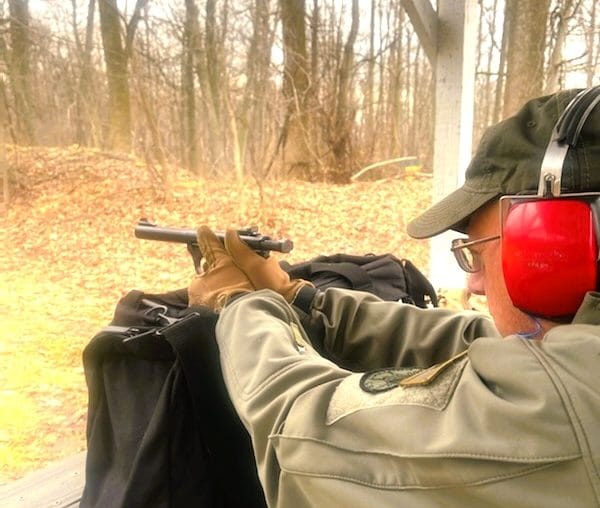
The trigger is quite good; upon going through the takeup, there is a wall, followed by a very clean break. It’s not necessarily a “light” pull but is very crisp and predictable and should please all but the most discriminating shooters. Let’s face it, there will be complainers, but in my opinion, if you can’t make the Ruger trigger work for you, you probably have no business picking up a pistol anyway. As with most other pistol triggers, this one is likely to smooth up with use over time. And I can promise you, this pistol is going to see a lot more use in the future, as many range trips will be had.
Not only will I get more trigger time with the MK IV, but my family will as well, as some fun training time will be had by all.
If you’re in the market for a reasonably priced, accurate, comfortable pistol that you won’t go broke feeding, that has Ruger’s awesome reputation behind it, then you need to pick up a Ruger Mark IV 22/45. It will bring you years of enjoyment, as well as put a smile on your face.

